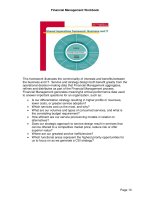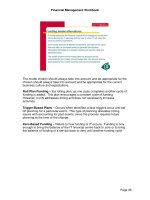The Financial Management Toolkit The Missing Financial Management Planning Process Theory and Tools Guide ITIL Compliant_6 pptx
Bạn đang xem bản rút gọn của tài liệu. Xem và tải ngay bản đầy đủ của tài liệu tại đây (104.53 KB, 13 trang )
Financial Management Workbook
Page 65
IT investment planning.
17. Will recommend scope for internal audits.
18. Will assist external auditors.
Detailed skills of the Financial Management process owner
The Financial Manager…
Description Notes/Comments
1. Must possess sound numerical and financial skills
2. Must have the ability to interact successfully with all
levels of Customer and IT organization management.
3. Must have a thorough approach to documentation and
schedules.
4. Must have excellent communication and negotiation
skills.
5. Must have good presentational skills.
6. Must understand the Customers' businesses and how
IT can affect the delivery of their products or services.
7. Must accountancy and company financial reporting
8. Must be capable of contract or supplier management.
9. Must be conversant with statistical and analytical
principles and processes.
Use the
notes/Comments
column in
different ways. If
you are looking
to apply for a
process role,
then you can
check yourself
against the list
(with ticks or look
to update your
resume).
If you are looking
to appoint a
process manager
or promote
someone from
within the
organization you
can make notes
about their
abilities in the
particular area.
Financial Management Workbook
Page 66
Template Job Description
The Chief Financial Officer (CFO)
1. Oversees all financial management activities relating to the
programs and operations of <<ORGANIZATION>> and reports
directly to the Administrator regarding financial management
matters.
2. Develops and maintains an integrated financial management
system that complies with applicable accounting principles,
standards, and other requirements of Federal, state and local
financial management systems.
3. Directs, manages, and provides policy guidance and oversight
of <<ORGANIZATION>> financial management personnel,
activities, and operations.
4. Monitors the financial execution of the <<ORGANIZATION>>
budget in relation to actual expenditures.
5. Works to ensure timely performance information for inclusion in
financial reports and statements.
6. Reviews on a <<time scale (e.g. monthly, quarterly)>> basis
the fees, royalties, rents, and other charges imposed by
<<ORGANIZATION>> for the services and things of value that it
provides and makes recommendations on revising those
charges to reflect the costs incurred in providing those services
and things of value.
Financial Management Workbook
Page 67
3.5 Business Justification Document
IT Services
Business Justification
Process: Financial Management
Status:
Version: 0.1
Release Date:
Financial Management Workbook
Page 68
Business Justification Document for Financial Management
The document is not to be considered an extensive statement as its topics
have to be generic enough to suit any reader for any organization.
However, the reader will certainly be reminded of the key topics that have to
be considered.
This document serves as a reference for HOW TO APPROACH THE
TASK OF SEEKING FUNDS for the implementation of the Financial
Management process.
This document provides a basis for completion within your own
organization.
This document was;
Prepared by:
On: <<date>>
And accepted by:
On: <<date>>
Financial Management Workbook
Page 69
Financial Management Business Justification
A strong enough business case will ensure progress and funds are made
available for any IT initiative.
This may sound like a bold statement but it is true. As IT professionals we
have (for too long) assumed that we miss out on funds why other functional
areas (e.g. Human resources and other shared services) seem to get all that
they want.
However, the problem is not with them, it’s with US. We are typically poor
salespeople when it comes to putting our case forward.
We try to impress with technical descriptions, rather than talking in a language
that a business person understands.
For example:
We say We should say
We have to increase IT security controls,
with the implementation of a new firewall.
Two weeks ago our biggest competitor
lost information that is now rumoured to
be available on the internet.
The network bandwidth is our biggest
bottleneck and we have to go to a
switched local environment.
The e-mail you send to the other national
managers will take 4 to 6 hours to be
delivered. It used to be 2 to 3 minutes,
but we are now using our computers for
so many more tasks.
Changes to the environment are
scheduled for a period of time when we
expect there to be minimal business
impact.
We are making the changes on Sunday
afternoon. There will be less people
working then.
Doesn’t that sound familiar?
To help reinforce this point even further, consider the situation of buying a
new fridge. What if the technically savvy sales person wants to explain “the
intricacies of the tubing structure used to super cool the high pressure gases,
which flow in an anti-clockwise direction in the Southern hemisphere”?
Wouldn’t you say “too much information, who cares – does it make things
cold?”
Well IT managers need to stop trying to tell business managers about the
tubing structure and just tell them what they are interested in.
Financial Management Workbook
Page 70
So let’s now look at some benefits of Financial Management. Remember that
the comments here are generic, as they have to apply to any organization.
Benefits Notes/Comments/Relevance
Through a properly controlled and structured
Financial Management process we will be able to
more effectively help in the alignment of the delivery
of IT service to the business requirements.
This is achieved through the nature of the process
by understanding such things as accounting
models, charging policies and having more accurate
information to help in the predication of budgets.
A better understanding of these three components
will allow more accurate spending on services that
are needed by the business.
A heightened visibility and increase communication
related to Financial Management of Services for
both business and IT support staff.
The reader should be able to draw upon experience
regarding the overall negative impact of the
business when IT departments have been
concerned with supplying high levels of services to
the business that have not been budgeted,
accounted for or being charged.
Organizations and therefore IT environments are
becoming increasing complex and continually facing
new challenges.
The ability to meet these challenges is dependent
on the speed and flexibility of the organization. The
ability to cope with more changes at the business
level will be directly impacted by how well IT
Departments can reduce the amount of time in loss
of service due to bad Financial Management
planning.
(Reader, here you can describe a missed
opportunity, due to bad Financial Management or a
process dragged down by bureaucracy, i.e. not
being able to deliver a critical service due to bad
budgeting or unforeseen events)
Financial Management Workbook
Page 71
Noticeable increases in the potential productivity of
end users and key personnel through reduced
interruption times, higher levels of availability as the
correct monies are being accounted for the right IT
Services.
The goal statement of Financial Management is to
provide stewardship of the costs for IT Services and
ensure alignment back to the business. By the very
nature of this statement we can expect to start
seeing a reduction in the costs of services due to
better planning.
Whether end users and staff take advantage of this
is not an issue for IT professionals to monitor.
Knowing that we have made an improvement is
what we need to publish.
An ITIL Financial Management process will guide
you towards understanding the financial implications
of all those necessary availability requirements
needed in the IT infrastructure.
This has real benefits as it may prevent an
organization from spending money on areas of the
IT Infrastructure where there really isn’t a need for
building high availability services for the business.
The Financial Manager will ensure that the cost of
service has been fully assessed prior to starting a
service improvement programme in conjunction with
Problem Management and Service Level
Management.
With a sound Financial Management process we
can expect an overall improvement in the level of
Availability as better planning can occur under a
structured, repeatable process.
Any ITIL process has the potential to increase the
credibility of the IT group, as they offer a higher
quality of service, combined with an overall
professionalism that can be lacking in ad-hoc
activities.
Refer also to the Financial Management Review Document for an assessment of
your current process
Financial Management Workbook
Page 72
Financial Management Workbook
Page 73
3.6 Accounting Policies
IT Services
Accounting Policies
Process: Financial Management
Status:
Version: 0.1
Release Date:
Financial Management Workbook
Page 74
Introduction
This document will give a brief introduction to the accounting for IT services.
It will give guidelines for the conversion of standard financial account and
centre information into cost of IT service.
What is accounting?
In the context of IT services, accounting is the activity that calculates the cost
of service and assigns this cost to the customers.
A cost model is the tool needed to calculate the cost of service. Activity
based costing is an effective method of modeling costs and its generation
gives information on what drives the costs and hence an indicator of where
costs can be reduced.
General Ledger
This is the traditional method of financial recording. Each cost is assigned to
a cost centre (a department, section, branch or unit) within the organization.
The cost is then allocated to an account code (e.g. pay, training, software,
hardware and so on) within the cost centre.
Financial Management Workbook
Page 75
Methods of Allocation
The methods of allocations are the means by which the general ledger costs
are assigned to activities e.g. people costs will be assigned on the basis of the
amount of time spent on each activity. A method of allocation is needed for
each account code in a particular cost centre.
Activities
These are all the activities performed. For IT departments these are generally
pitched in technical terminology.
Cost Drivers
The cost driver is how an activity is assigned to a service and/or customer.
This is usually phrased in business terminology and is the best means for
having a business volume metric linked to IT cost of service.
Services and Customers
These are the customers and services that drive the IT costs. Irrespective of
whether IT charges it needs to understand which services and customers are
driving its costs.
Building a Cost Model
Different organizations have different complexities and the tool used to build a
cost model can vary from a simple spreadsheet to using specialty software.
The skill is to have enough detail available to make good business decisions
while not going into too much detail and having a high maintenance cost.
Financial Management Workbook
Page 76
Financial Management Workbook
Page 77
3.7 Budgeting Guidelines
IT Services
Budgeting Guidelines
Process: Financial Management
Status:
Version: 0.1
Release Date:









